Sealife guideThe fascinating world of starfish: biology and ecologyThe marine echinoderms
Last updated on 09/08/2025 at 11:26 PM
Taxonomy
- Embranchement: Echinodermes
- Classe:

The red starfish is a member of the class Asteroidea
Description
Asteroids represent one of the best-known classes of echinoderms. In fact, if I tell you that asteroids are simply starfish, you’ll immediately recognize them.
Starfish include more than 1,600 species.
Starfish can reach over 3 feet across when their arms are fully extended.
Starfish usually have 5 arms or a multiple of 5. This number can change during their lifetime if, after the loss of an arm, regeneration produces two new arms instead of one.
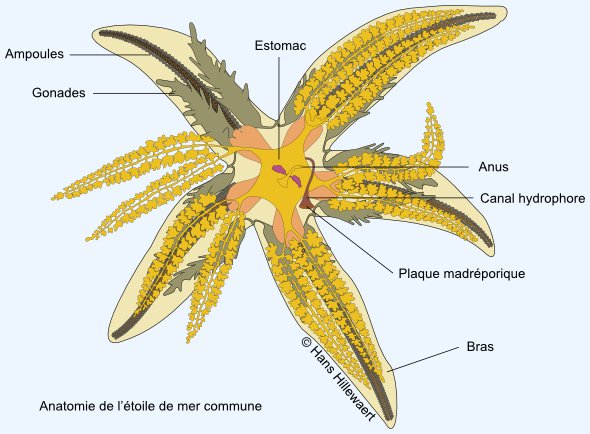
Anatomy of the common starfish
The skeleton of a starfish is made of calcareous plates that are adjacent but not fused together.
To move around, a starfish uses an ambulacral system made up of two types of tube feet:
- with suction cups for hard substrates
- without suction cups for soft substrates
Geographic range
Starfish are found at all latitudes and at all depths, from the surface waters down to the deep sea.
Diet
To feed, starfish use a truly unique digestive strategy. They can evert their stomach, meaning they push it outside their body, directly onto their prey. This allows them to secrete digestive enzymes that begin breaking down the tissues of the captured animal, most often bivalve mollusks such as mussels or scallops. Once the flesh is softened and partially digested, the starfish retracts its stomach back into its body to complete digestion and absorb nutrients. This ingenious mechanism enables them to consume prey larger than their mouth might suggest.
Reproduction
Starfish have one pair of gonads in each arm. However, it is very difficult to determine the sex of a starfish.
Starfish can also reproduce asexually by splitting off part of the central disc along with one arm, then regenerating the missing arms.
Did you know ?
Starfish have phenomenal strength: using their powerful tube feet equipped with suction cups, they are capable of prying open the shells of a bivalves such as a great Atlantic scallop.
Acanthaster planci, also known as the crown-of-thorns starfish, is responsible for major damage to coral reefs, which it feeds on voraciously.
Starfish can also cause serious damage in mussel farms.
Discover jellyfish
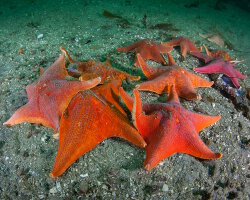
Bat sea star
(Patiria miniata)
(Patiria miniata)
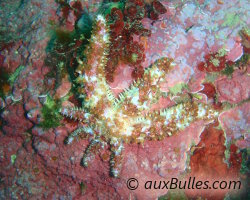
Blue spiny starfish
(Coscinasterias tenuispina)
(Coscinasterias tenuispina)
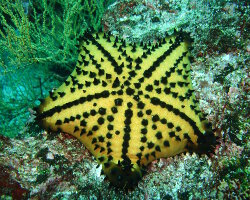
Chocolate chip sea star
(Nidorellia armata)
(Nidorellia armata)

Cushion starfish
(Culcita novaeguineae)
(Culcita novaeguineae)
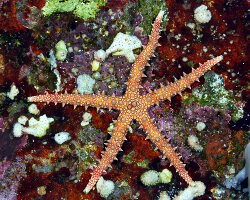
Egyptian sea star
(Gomophia egyptiaca)
(Gomophia egyptiaca)
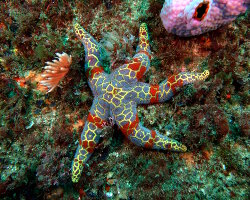
Mosaic sea star
(Plectaster decanus)
(Plectaster decanus)
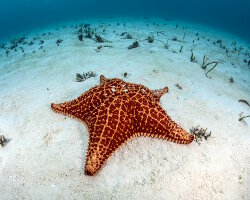
Red cushion sea star
(Oreaster reticulatus)
(Oreaster reticulatus)
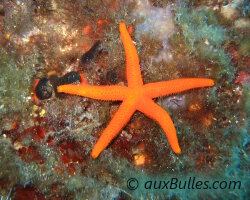
Red starfish
(Echinaster sepositus)
(Echinaster sepositus)
Our latestUpdates

Saturday, November 15th 2025
Batz island
Located in the English Channel off the northern coast of Brittany, just a few kilometers from the town of Roscoff, Batz island is a true little haven of peace where you can enjoy its wild landscapes, unspoiled beaches and historical heritage.
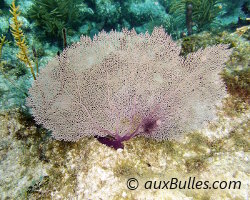
Friday, November 7th 2025
The common sea fan
The common sea fan, is a type of soft coral found in the warm, shallow waters of the Caribbean and the western Atlantic ocean. It grows in wide, fan-shaped forms that sway gently with the ocean currents, helping it catch tiny food particles drifting by. Its beautiful purple branches are covered by a thin living tissue that hosts tiny algae, which provide much of the coral's energy through sunlight.
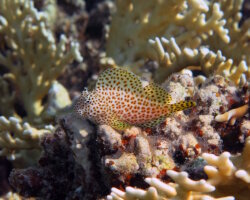
Thursday, October 30th 2025
The leopard blenny
The leopard blenny is a small reef fish from the Indo-Pacific ocean. It is easily recognized by its spotted coloration, which resembles that of a leopard. It lives on shallow coral reefs, feeds mainly on algae and polyps and skillfully camouflages among the corals to avoid predators.
Photo of the Day

Grand requin marteau
(Sphyrna mokarran)
(Sphyrna mokarran)
